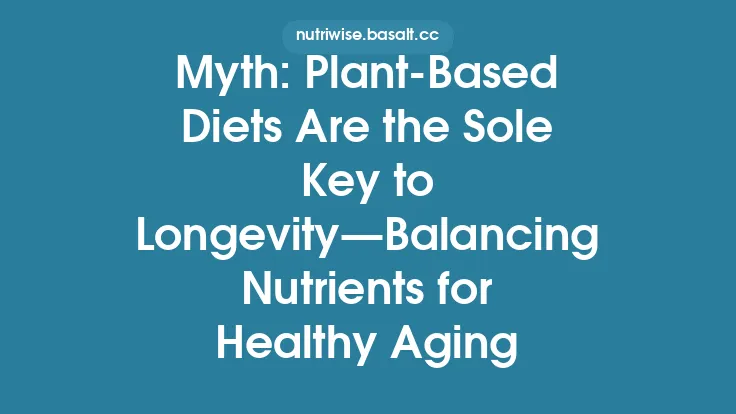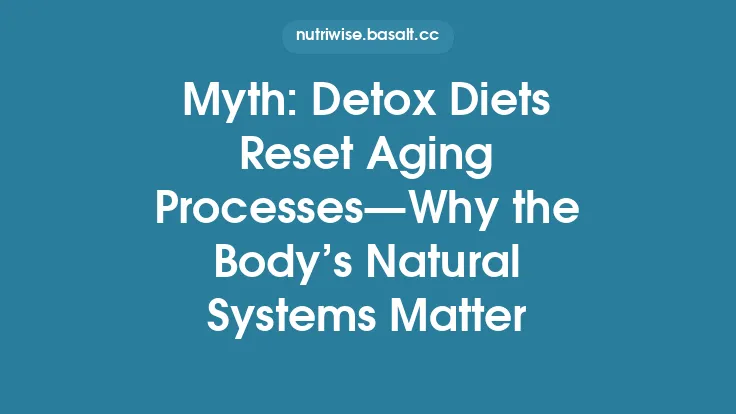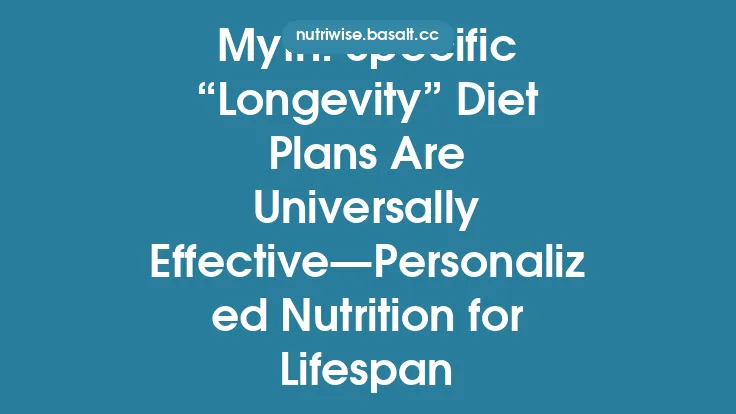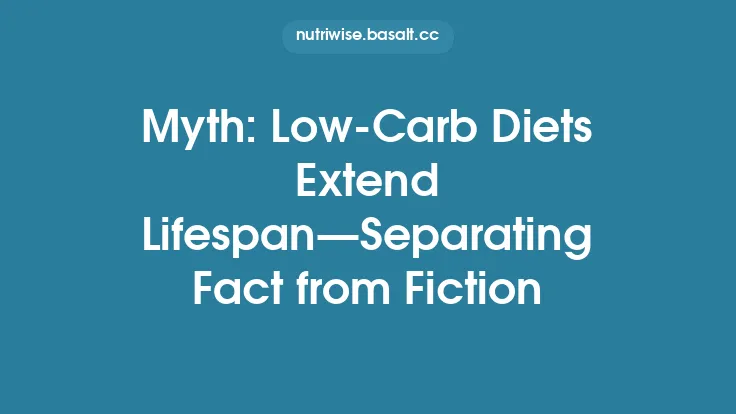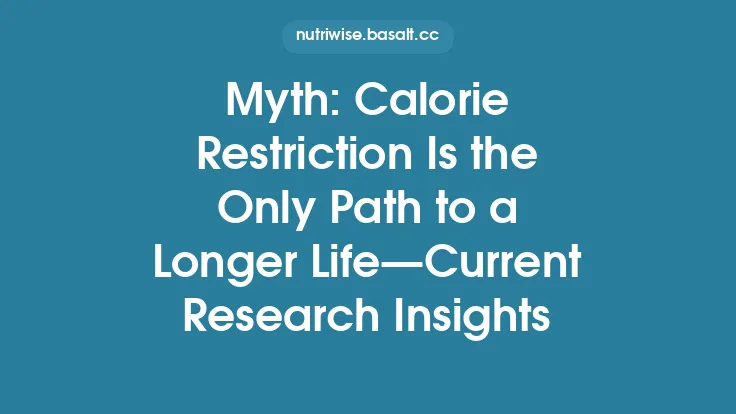High‑protein diets have become a staple of modern nutrition advice, especially among athletes, body‑builders, and anyone looking to preserve muscle mass as they age. Yet a persistent claim circulates in health blogs and social media: “Eating lots of protein speeds up aging.” This myth conflates the complex biochemical effects of protein with the multifactorial process of aging, leading many to either over‑restrict protein or, conversely, consume it without regard for quality or timing. Below we unpack the science, examine the evidence, and offer practical guidance for using protein to support—not sabotage—longevity.
Understanding Protein and the Biology of Aging
Proteins are the building blocks of every cell. They provide structural components (collagen, elastin), enzymes that catalyze metabolic reactions, transporters, hormones, and antibodies. As we age, several physiological systems that depend on protein begin to falter:
- Sarcopenia – the age‑related loss of skeletal muscle mass and strength, which contributes to frailty, falls, and metabolic dysregulation.
- Immune senescence – diminished production of naïve T‑cells and reduced antibody responses, partly linked to insufficient amino acid availability.
- Skin integrity – collagen turnover slows, leading to loss of elasticity and delayed wound healing.
Because protein directly supplies the amino acids required for these processes, it is intuitive to think that more protein could help maintain youthful function. However, protein also activates signaling pathways that influence cellular growth, repair, and longevity, creating a nuanced balance.
Key Molecular Pathways Linking Protein Intake to Longevity
| Pathway | Primary Trigger | Effect on Aging | How Protein Influences It |
|---|---|---|---|
| mTORC1 (mechanistic target of rapamycin complex 1) | Leucine, arginine, and other branched‑chain amino acids (BCAAs) | Promotes protein synthesis, cell growth, and inhibits autophagy. Chronic activation is associated with accelerated cellular aging and age‑related diseases. | High acute protein loads, especially rich in leucine, strongly stimulate mTORC1. |
| IGF‑1 (insulin‑like growth factor‑1) | Dietary protein, especially animal protein, raises circulating IGF‑1. | IGF‑1 supports growth and anabolic processes but can also drive cellular proliferation and reduce stress resistance when persistently elevated. | Moderate protein intake maintains IGF‑1 at levels that support muscle without excessive mitogenic signaling. |
| AMPK (AMP‑activated protein kinase) | Low energy states, exercise, caloric restriction | Enhances mitochondrial biogenesis, promotes autophagy, and improves metabolic health. | High protein without adequate carbohydrate can blunt AMPK activation, whereas balanced meals preserve its activity. |
| Sirtuins (e.g., SIRT1) | NAD⁺ availability, caloric restriction | Regulate DNA repair, inflammation, and metabolic efficiency. | Certain amino acids (e.g., tryptophan) can influence NAD⁺ synthesis, indirectly affecting sirtuin activity. |
| Autophagy | Nutrient deprivation, low mTORC1 activity | Cellular “clean‑up” that removes damaged proteins and organelles, a process linked to longevity. | Excessive protein intake suppresses autophagy; intermittent lower‑protein periods can restore it. |
The central theme is that protein is a double‑edged sword: it supplies essential substrates for maintenance, yet it can also drive growth‑promoting pathways that, when over‑activated, may shorten cellular lifespan. The key is moderation, timing, and source.
Evidence from Human Observational Studies
Large cohort studies have examined protein intake in relation to mortality and age‑related disease risk. While results vary by population, several consistent patterns emerge:
- U‑shaped relationship – Both very low (<0.6 g·kg⁻¹·day⁻¹) and very high (>1.6 g·kg⁻¹·day⁻¹) protein intakes are associated with increased all‑cause mortality, especially when the high intake is dominated by red and processed meat. Moderate intakes (0.8–1.2 g·kg⁻¹·day⁻¹) tend to show the lowest risk.
- Age‑specific trends – In adults over 65, higher protein (≈1.2 g·kg⁻¹·day⁻¹) correlates with reduced risk of frailty, falls, and mortality, whereas in younger adults the same level does not confer additional survival benefit and may be linked to higher incidence of certain cancers if the protein source is predominantly animal.
- Source matters – Plant‑based proteins (legumes, nuts, soy) are generally associated with lower cardiovascular risk and similar or better mortality outcomes compared with animal proteins, even when total protein quantity is matched.
- Kidney function – In individuals with normal renal function, higher protein intake does not accelerate decline in glomerular filtration rate (GFR). However, in those with pre‑existing chronic kidney disease, excessive protein can hasten progression, underscoring the need for personalized recommendations.
These observational data suggest that protein per se does not “accelerate aging”; rather, the amount, source, and the individual's physiological context determine the net effect on longevity.
Insights from Controlled Intervention Trials
Randomized controlled trials (RCTs) provide a higher level of evidence, though long‑term trials on mortality are scarce due to logistical constraints. Key findings from the available literature include:
- Sarcopenia prevention – Trials in older adults (≥70 y) supplementing 1.2–1.5 g·kg⁻¹·day⁻¹ of high‑quality protein (whey or soy) combined with resistance training preserve lean mass and improve functional outcomes without adverse effects on biomarkers of aging (e.g., inflammatory cytokines).
- Metabolic health – Moderate protein (≈20 % of total calories) in the context of a balanced diet improves insulin sensitivity and reduces fasting glucose compared with low‑protein, high‑carbohydrate diets, especially when the protein is sourced from fish, dairy, or legumes.
- mTORC1 modulation – Short‑term feeding studies demonstrate that a single high‑protein meal spikes plasma leucine and mTORC1 signaling for up to 3 hours. When protein is distributed evenly across three meals, the peak activation is blunted, suggesting that protein timing can mitigate chronic pathway over‑activation.
- Longevity biomarkers – In a 2‑year trial of middle‑aged adults, a diet providing 1.0 g·kg⁻¹·day⁻¹ of mixed plant and animal protein resulted in lower telomere attrition rates and reduced circulating IGF‑1 compared with a low‑protein (0.6 g·kg⁻¹·day⁻¹) diet, indicating a potential protective effect on cellular aging.
Overall, RCTs support the notion that adequate, well‑distributed protein intake supports muscle health and metabolic function without necessarily accelerating aging, provided the diet is not excessively protein‑rich and is balanced with other macronutrients.
Animal Model Findings: What They Tell Us and Their Limits
Animal studies, particularly in rodents, have been instrumental in dissecting mechanistic links between protein and lifespan:
- Methionine restriction – Reducing dietary methionine (an essential amino acid) extends lifespan in mice by up to 30 %. This effect is mediated through reduced oxidative stress and enhanced autophagy. However, methionine restriction also reduces overall protein synthesis, which can be detrimental in older animals.
- Protein‑to‑carbohydrate ratio – In flies and mice, diets with a low protein‑to‑carbohydrate ratio (≈1:10) increase lifespan, whereas high protein (≥30 % of calories) shortens it. Yet, when the high‑protein diet is paired with regular exercise, the negative impact on lifespan diminishes, highlighting the interplay between diet and physical activity.
- Source specificity – Mice fed casein (milk protein) versus soy protein show different aging trajectories; soy‑fed mice exhibit lower IGF‑1 and reduced tumor incidence, suggesting that protein source influences longevity pathways.
While these models provide valuable mechanistic insight, extrapolation to humans must be cautious. Human metabolism, lifespan, and environmental exposures differ substantially, and the protein amounts used in many animal studies are often far beyond typical human consumption.
Protein Source Matters: Animal vs. Plant Proteins
The debate over animal versus plant protein is often oversimplified. A nuanced view considers amino acid composition, bioavailability, and accompanying nutrients:
| Attribute | Animal Protein | Plant Protein |
|---|---|---|
| Complete amino acid profile | Generally complete (e.g., whey, eggs) | Often limited in one or more essential amino acids (e.g., lysine in cereals) but can be complemented (rice + beans). |
| Leucine content | High, potent mTORC1 activator | Moderate; legumes provide sufficient leucine when portioned appropriately. |
| Associated micronutrients | Rich in vitamin B12, heme iron, zinc, and saturated fat (varies). | High in fiber, phytochemicals, unsaturated fats, and antioxidants. |
| Impact on IGF‑1 | Tends to raise circulating IGF‑1 more markedly. | Produces a modest IGF‑1 response. |
| Health outcomes | Linked to higher cardiovascular risk when derived from processed/red meat; neutral or beneficial when from fish, poultry, dairy. | Associated with lower cardiovascular disease and cancer risk when consumed as part of a plant‑forward diet. |
For longevity, the evidence leans toward a mixed protein pattern: prioritize high‑quality animal sources such as fish, poultry, eggs, and dairy for their complete amino acid profile, while incorporating plant proteins (legumes, nuts, seeds) to provide fiber, phytonutrients, and a more moderate IGF‑1 response.
Quantity, Timing, and Distribution of Protein Across the Day
- Total Daily Amount
- Adults 18‑64 y: 0.8–1.0 g·kg⁻¹·day⁻¹ is sufficient for most individuals.
- Older adults (≥65 y): 1.1–1.5 g·kg⁻¹·day⁻¹ helps counteract sarcopenia.
- Athletes or those in heavy resistance training: 1.6–2.2 g·kg⁻¹·day⁻¹ may be justified, but should be cycled with lower‑protein periods to avoid chronic mTORC1 over‑activation.
- Meal Distribution
- Even spacing (≈0.3–0.4 g·kg⁻¹ per meal) maximizes muscle protein synthesis (MPS) and reduces prolonged spikes in mTORC1.
- Protein‑rich breakfast can improve satiety and glycemic control throughout the day, supporting metabolic health.
- Pre‑ and Post‑Exercise Protein
- Consuming 20–30 g of high‑leucine protein within 30 minutes after resistance training optimally stimulates MPS without excessively prolonging mTORC1 activation.
- Intermittent Low‑Protein Windows
- Incorporating 12‑hour periods of lower protein (e.g., overnight fast) allows autophagy to proceed, balancing growth and repair pathways.
Age‑Specific Recommendations
| Life Stage | Recommended Protein (g·kg⁻¹·day⁻¹) | Key Focus |
|---|---|---|
| Young adults (18‑30 y) | 0.9–1.0 | Support growth, maintain lean mass, avoid excessive IGF‑1 elevation. |
| Middle‑aged (31‑64 y) | 1.0–1.2 | Preserve muscle, manage metabolic health, balance mTORC1 activity. |
| Older adults (≥65 y) | 1.2–1.5 | Counteract sarcopenia, support immune function, ensure adequate leucine. |
| Very old (≥80 y) | 1.3–1.6 (if renal function permits) | Emphasize protein quality, distribute across meals, combine with resistance activity. |
These ranges assume normal kidney function and a balanced diet. Individuals with specific medical conditions (e.g., chronic kidney disease, liver disease) should consult healthcare professionals for tailored targets.
Practical Strategies to Optimize Protein for Healthy Aging
- Prioritize high‑leucine sources – whey, Greek yogurt, eggs, soy, and lean meats provide ~2–3 g leucine per 20 g protein serving, the threshold for maximal MPS.
- Combine plant proteins – pair grains with legumes (e.g., rice‑beans) to achieve a complete amino acid profile without relying solely on animal products.
- Space protein evenly – aim for 25–30 g of protein at breakfast, lunch, and dinner; add a small protein‑rich snack (e.g., cottage cheese, a handful of nuts) if needed.
- Include resistance training – at least two sessions per week amplify the benefits of dietary protein on muscle preservation.
- Mind the overall diet – ensure adequate intake of omega‑3 fatty acids, antioxidants, and fiber, which can counterbalance any pro‑aging signals from high protein.
- Monitor biomarkers – periodic checks of serum IGF‑1, creatinine, and inflammatory markers can help fine‑tune protein intake, especially in older adults.
- Consider “protein cycling” – alternate weeks of higher protein (e.g., 1.5 g·kg⁻¹·day⁻¹) with weeks of moderate protein (0.9 g·kg⁻¹·day⁻¹) to provide growth periods while allowing autophagic recovery.
Common Misinterpretations and How to Evaluate New Research
- “More protein = longer life.” – This oversimplifies a U‑shaped dose‑response curve. Excessive protein can chronically stimulate mTORC1 and IGF‑1, potentially accelerating cellular aging if not balanced with periods of lower intake.
- “All animal protein is bad for longevity.” – The risk is largely driven by processed/red meat consumption. Fish, poultry, eggs, and dairy have neutral or even beneficial associations when consumed in moderation.
- “Plant protein alone is enough for older adults.” – While plant proteins are healthful, older adults often need higher leucine doses; supplementing with a modest amount of high‑quality animal protein can ensure sufficient MPS.
- “If I’m exercising, I can ignore protein timing.” – Timing still matters; post‑exercise protein maximizes muscle repair, and spreading intake reduces prolonged mTORC1 activation.
- “Animal studies prove high protein shortens lifespan in humans.” – Species differences, diet composition, and environmental factors limit direct translation. Human data show a more nuanced picture.
When reading new studies, ask:
- Population – Age, health status, and baseline diet matter.
- Protein source and quality – Is it whey, soy, red meat, etc.?
- Duration – Short‑term metabolic outcomes differ from long‑term mortality data.
- Control of confounders – Physical activity, total caloric intake, and other nutrients can skew results.
Bottom Line: Balancing Protein for Longevity
Protein is indispensable for maintaining the structural and functional integrity of the body throughout life. The myth that “high‑protein diets accelerate aging” stems from a misreading of mechanistic data and an overgeneralization of dose‑response relationships. The evidence converges on a balanced approach:
- Consume enough protein to support muscle, immune, and skin health—especially after age 65.
- Distribute intake across meals to avoid chronic overstimulation of growth pathways.
- Choose high‑quality sources and blend animal and plant proteins to reap the benefits of complete amino acid profiles while moderating IGF‑1 spikes.
- Pair protein with regular resistance exercise and periods of lower protein intake to allow autophagy and cellular repair.
By respecting the body’s dual need for building blocks and for regulated growth signaling, individuals can harness protein as a tool for healthy aging rather than a hidden accelerator of the aging clock.
